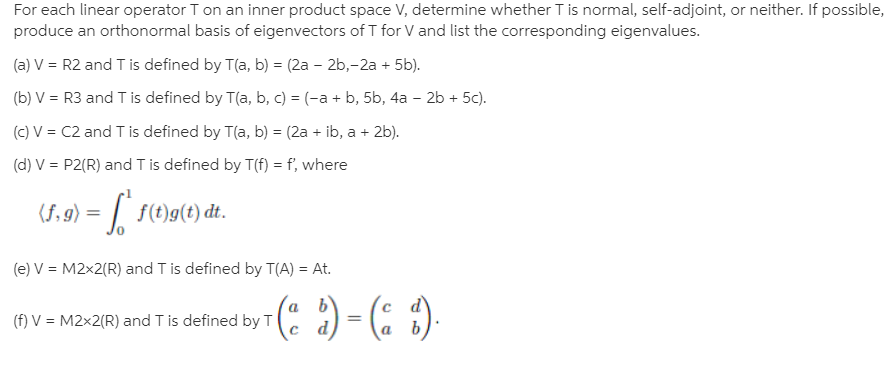
Algebra & Trigonometry with Analytic Geometry
13th Edition
ISBN: 9781133382119
Author: Swokowski
Publisher: Cengage
expand_more
expand_more
format_list_bulleted
Question

Transcribed Image Text:For each linear operator T on an inner product space V, determine whether T is normal, self-adjoint, or neither. If possible,
produce an orthonormal basis of eigenvectors of T for V and list the corresponding eigenvalues.
(a) V = R2 and T is defined by T(a, b) = (2a - 2b,-2a + 5b).
(b) V = R3 and T is defined by T(a, b, c) = (-a + b, 5b, 4a - 2b + 5c).
(c) V = C2 and T is defined by T(a, b) = (2a + ib, a + 2b).
(d) V = P2(R) and T is defined by T(f) = f', where
(S, 9) = | s(0)g(t) dt.
(f.
(e) V = M2x2(R) and T is defined by T(A) = At.
%3!
(* :) - (: )
(f) V = M2x2(R) and T is defined by T
%3D
Expert Solution
This question hasn't been answered yet.
Check out a sample Q&A hereWhile we curate your solution, check out other similar questions below!

©
Algebra & Trigonometry with Analytic Geometry
13th Edition
Knowledge Booster
Similar questions
- Consider again the matrix A in Exercise 35. Give conditions on a, b, c, and d such that A has two distinct real eigenvalues, one real eigenvalue, and no real eigenvalues.arrow_forwardDetermine all nn symmetric matrices that have 0 as their only eigenvalue.arrow_forwardDefine T:P2P2 by T(a0+a1x+a2x2)=(2a0+a1a2)+(a1+2a2)xa2x2. Find the eigenvalues and the eigenvectors of T relative to the standard basis {1,x,x2}.arrow_forward
arrow_back_ios
arrow_forward_ios
Recommended textbooks for you
- Algebra & Trigonometry with Analytic GeometryAlgebraISBN:9781133382119Author:SwokowskiPublisher:Cengage
 Linear Algebra: A Modern IntroductionAlgebraISBN:9781285463247Author:David PoolePublisher:Cengage Learning
Linear Algebra: A Modern IntroductionAlgebraISBN:9781285463247Author:David PoolePublisher:Cengage Learning Elementary Linear Algebra (MindTap Course List)AlgebraISBN:9781305658004Author:Ron LarsonPublisher:Cengage Learning
Elementary Linear Algebra (MindTap Course List)AlgebraISBN:9781305658004Author:Ron LarsonPublisher:Cengage Learning

Algebra & Trigonometry with Analytic Geometry
Algebra
ISBN:9781133382119
Author:Swokowski
Publisher:Cengage

Linear Algebra: A Modern Introduction
Algebra
ISBN:9781285463247
Author:David Poole
Publisher:Cengage Learning

Elementary Linear Algebra (MindTap Course List)
Algebra
ISBN:9781305658004
Author:Ron Larson
Publisher:Cengage Learning